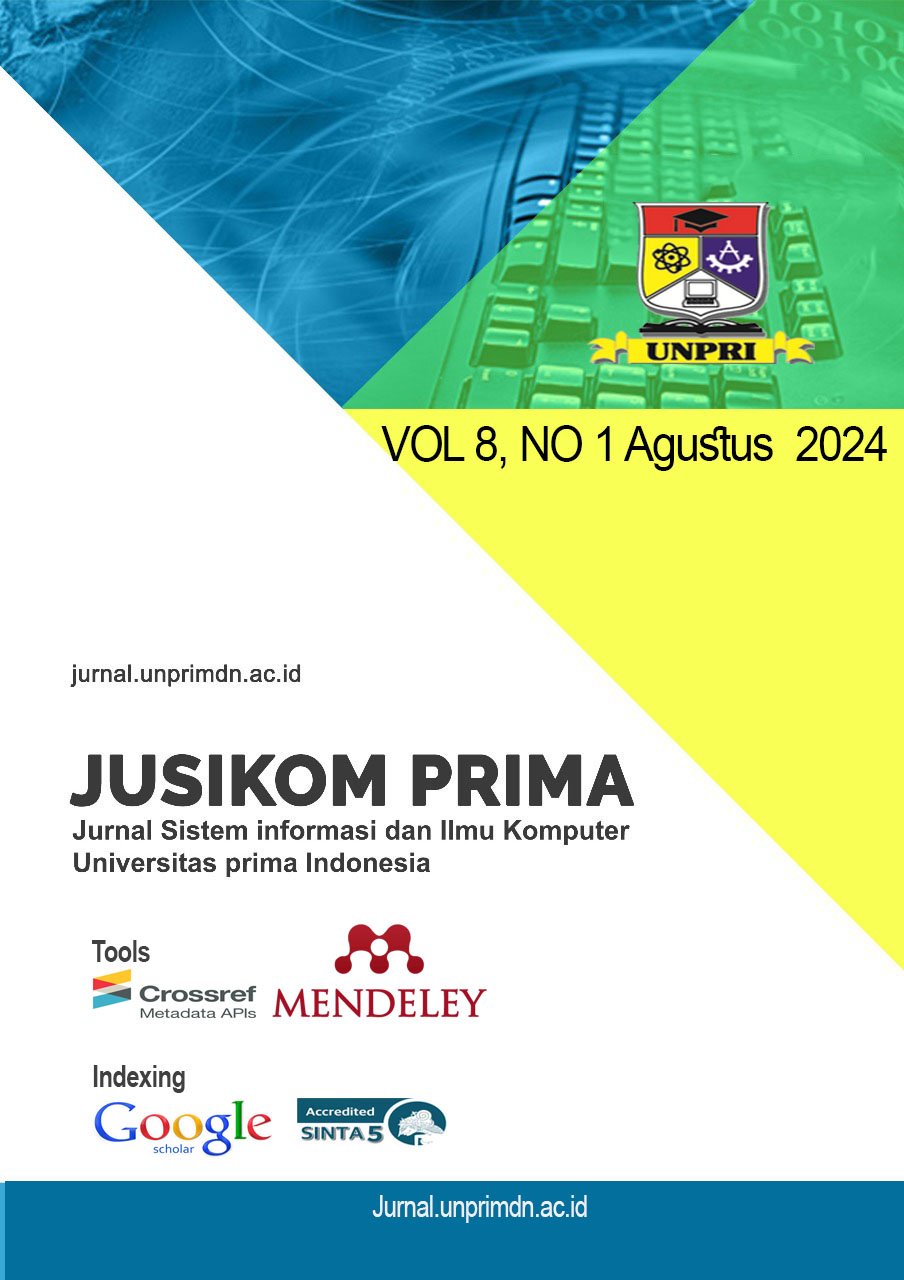Comparison of K-Nearest Neighbors and Convolutional Neural Network Algorithms in Potato Leaf Disease Classification
DOI:
https://doi.org/10.34012/jurnalsisteminformasidanilmukomputer.v8i1.5337Abstract
tatang.rohana@ubpkarawang.ac.id3, santi.arum@ubpkarawang.ac.id4, deden.wahiddin@ubpkarawang.ac.id5
ABSTRACT
Potato production in Central Java was recorded to have decreased by 10.77% by the Central Statistics Agency (BPS), from 278,717 tons in 2022 to 248,700 tons in 2023. This decline is due to the fact that potatoes are susceptible to diseases such as late blight and dry spot (early blight) which can significantly reduce yields. This study aims to evaluate the performance of Convolutional Neural Network (CNN) with VGG16 architecture and K-Nearest Neighbors (KNN) to find the best method for potato late blight classification. The dataset used consists of 1500 potato leaf images divided into training, validation, and testing. This research uses pre- processing including resizing, rescaling, and data augmentation. The results show that CNN with the VGG16 model is superior in classifying potato leaf diseases compared to KNN with the MobileNetV2 model. CNN produced an accuracy of 96% while KNN with the MobileNetV2 model obtained an accuracy of 93%. These results can be used as a powerful tool in supporting potato leaf disease identification. This model makes a significant contribution to the development of disease identification techniques through digital image processing.
Keywords: Potato Leaf Disease, Convolutional Neural Network, VGG16, K-Nearest
References
E. C. I. S. W. Nugraheni and E. Ratnasari, “Biobakterisida Ekstrak Daun Dewandaru (Eugenia uniflora) dalam Menghambat Bakteri Layu (Ralstonia solanacearum) pada Tanaman Kentang,” LenteraBio : Berkala Ilmiah Biologi, vol. 10, no. 3, pp. 366–374, 2021, doi: https://doi.org/10.26740/lenterabio.v10n3.p366-374.
Badan Pusat Statistik, “Produksi Tanaman Sayuran 2021-2023.” Accessed: Jun. 26, 2024. [Online]. Available: https://www.bps.go.id/id/statistics-table/2/NjEjMg==/produksi-tanaman-sayuran.html
P. T. Ompusunggu, “Klasifikasi Penyakit Tanaman Pada Daun Kentang Dengan Metode Convolutional Neural Network Arsitektur Mobilenet,” Jurnal Syntax Fusion, vol. 2, no. 9, pp. 740–751, Sep. 2022, doi: 10.54543/fusion.v2i09.217.
A. Lesmana, R. P. Fadhillah, and C. Rozikin, “Identifikasi Penyakit pada Citra Daun Kentang Menggunakan Convolutional Neural Network (CNN),” Jurnal Sains dan Informatika (JSI), vol. 8, no. 1, pp. 21–30, 2022, doi: https://doi.org/10.34128/jsi.v8i1.377.
Y. Muliani, R. Robana, and I. Mulyati, “Aplikasi Agensia Hayati Trichoderma harzianum Rifai. untuk Menekan Phytophtora infestans (Mont.) Penyebab Penyakit Busuk Daun pada Tanaman Kentang (Solanum tuberosum L.),” AGROSCRIPT: Journal of Applied Agricultural Sciences, vol. 5, no. 1, pp. 52–64, May 2023, doi: 10.36423/agroscript.v5i1.1245.
S. Lestari and K. I. Nauval, “Implementasi Deteksi Objek Penyakit Daun Kentang Dengan Metode Convolutional Neutral Network,” Jurnal Aplikasi Teknologi Informasi dan Manajemen (JATIM), vol. 3, no. 2, pp. 136–149, 2022, doi: https://doi.org/10.31102/jatim.v3i2.1576.
A. Saputro, S. Mu’min, M. Lutfi, and H. Putri, “Deep Transfer Learning Dengan Model Arsitektur VGG16 Untuk Klasifikasi Jenis Varietas Tanaman Lengkeng Berdasarkan Citra Daun,” Jurnal Mahasiswa Teknik Informatika, vol. 6, no. 2, pp. 609–614, 2022, doi: https://doi.org/10.36040/jati.v6i2.5456.
M. K. Santosa, M. H. P. Swari, and A. N. Sihananto, “Implementasi Arsitektur Alexnet Dan Resnet34 Pada Klasifikasi Citra Penyakit Daun Kentang Menggunkan Transfer Learning,” Jurnal Mahasiswa Teknik Informatika, vol. 7, no. 5, pp. 3293–3301, 2023, doi: https://doi.org/10.36040/jati.v7i5.7337.
R. Yati, T. Rohana, and A. Rizky Pratama, “Klasifikasi Jenis Mangga Menggunakan Algoritma Convolutional Neural Network,” JURNAL MEDIA INFORMATIKA BUDIDARMA, vol. 7, no. 3, pp. 1265–1275, 2023, doi: 10.30865/mib.v7i3.6445.
F. D. Utari, A. M. Siregar, and D. Wahiddin, “Implementasi Algoritme K-Nearest Neighboar (KNN) untuk Prediksi Hasil Produksi,” Scientific Student Journal for Information, Technology and Science, vol. 1, no. 1, pp. 21–25, 2020, Accessed: Jun. 23, 2024. [Online]. Available: https://journal.ubpkarawang.ac.id/mahasiswa/index.php/ssj/index
M. R. Ramadhan, Y. Cahyana, and A. R. Juwita, “Penerapan Algoritma K-Nearest Neighbor dan C4.5 untuk Klasifikasi Penyakit Kanker Serviks,” Scientific Student Journal for Information, Technology and Science, vol. 5, no. 1, pp. 86–95, 2024, Accessed: Jun. 23, 2024. [Online]. Available: https://journal.ubpkarawang.ac.id/mahasiswa/index.php/ssj/article/view/989
B. M. W. Tranose, H. H. Handayani, and S. A. P. Lestari, “Penerapan Algoritma K-Nearest Neighbor Dengan Pengolahan Citra Digital Untuk Mengidentifikasi Jenis Kayu,” Scientific Student Journal for Information, Technology and Science, vol. 4, no. 2, pp. 102–110, 2023, Accessed: Jun. 23, 2024. [Online]. Available: https://journal.ubpkarawang.ac.id/mahasiswa/index.php/ssj/article/view/973
S. Nurjanah, A. M. Siregar, and D. S. Kusumaningrum, “Penerapan Algoritma K – Nearest Neighbor (Knn) Untuk Klasifikasi Pencemaran Udara Di Kota Jakarta,” Scientific Student Journal for Information, Technology and Science, vol. 1, no. 2, pp. 71–76, Jul. 2020, Accessed: Jul. 03, 2024. [Online]. Available: http://journal.ubpkarawang.ac.id/mahasiswa/index.php/ssj/issue/view/53
K. L. Kohsasih, M. D. A. Rizky, T. Fahriyani, V. Wijaya, and R. Rosnelly, “Analisis Perbandingan Algoritma Convolutional Neural Network dan Algoritma Multi-layer Perceptron Neural dalam Klasifikasi Citra Sampah,” Times, vol. 10, no. 2, pp. 22–28, 2021, [Online]. Available: http://ejournal.stmik-time.ac.id
J. R. Aisya and A. Prasetiadi, “Klasifikasi Penyakit Daun Kentang dengan Metode CNN dan RNN,” Jurnal Tekno Insentif, vol. 17, no. 1, pp. 1–10, Apr. 2023, doi: 10.36787/jti.v17i1.888.
Moch. R. Yuliansyah, M. B, and A. Franz, “Perbandingan Metode K-Nearest Neighbors dan Naïve Bayes Classifier Pada Klasifikasi Status Gizi Balita di Puskesmas Muara Jawa Kota Samarinda,” Adopsi Teknologi dan Sistem Informasi (ATASI), vol. 1, no. 1, pp. 08–20, Jun. 2022, doi: 10.30872/atasi.v1i1.25.
H. H. Sutarno, R. Latuconsina, and A. Dinimaharawati, “Prediksi Stunting Pada Balita Dengan Menggunakan Algoritma Klasifikasi K-Nearest Neighbors,” eProceedings of Engineering, vol. 8, no. 5, pp. 6657–6661, 2021, Accessed: Jun. 26, 2024. [Online]. Available: https://openlibrarypublications.telkomuniversity.ac.id/index.php/engineering/article/view/16456
O. V. Putra, M. Z. Mustaqim, and D. Muriatmoko, “Transfer Learning untuk Klasifikasi Penyakit dan Hama Padi Menggunakan MobileNetV2,” Techno.Com, vol. 22, no. 3, pp. 562–575, Aug. 2023, doi: 10.33633/tc.v22i3.8516.
Downloads
Published
How to Cite
Issue
Section
License
Copyright (c) 2024 Trisya Nurmayanti, Dina Hartini, Tatang Rohana, Santi Arum Puspita Lestari, Deden Wahiddin

This work is licensed under a Creative Commons Attribution-ShareAlike 4.0 International License.
Authors who publish their manuscripts through the Journal of Information Systems and Computer Science agree to the following:
- Copyright to the manuscripts of scientific papers in this Journal is held by the author.
- The author surrenders the rights when first publishing the manuscript of his scientific work and simultaneously the author grants permission / license by referring to the Creative Commons Attribution-ShareAlike 4.0 International License to other parties to distribute his scientific work while still giving credit to the author and the Journal of Information Systems and Computer Science as the first publication medium for the work.
- Matters relating to the non-exclusivity of the distribution of the Journal that publishes the author's scientific work can be agreed separately (for example: requests to place the work in the library of an institution or publish it as a book) with the author as one of the parties to the agreement and with credit to sJournal of Information Systems and Computer Science as the first publication medium for the work in question.
- Authors can and are expected to publish their work online (e.g. in a Repository or on their Organization's/Institution's website) before and during the manuscript submission process, as such efforts can increase citation exchange earlier and with a wider scope.














